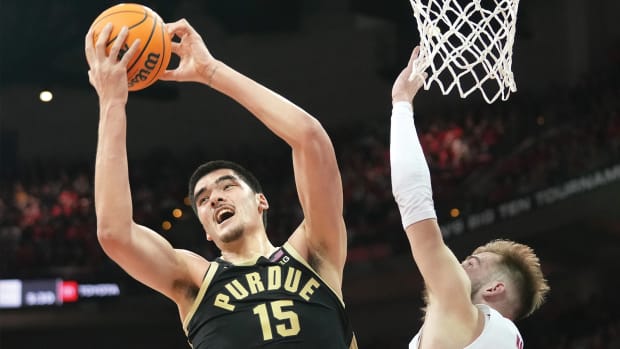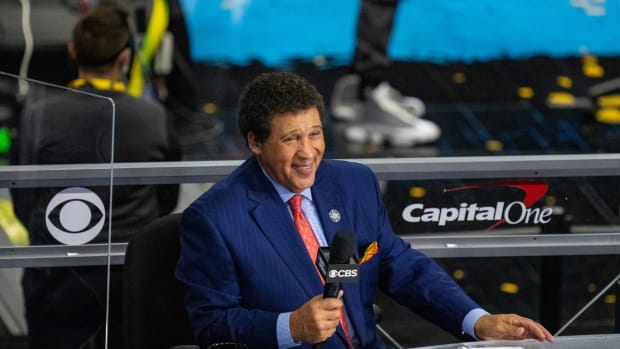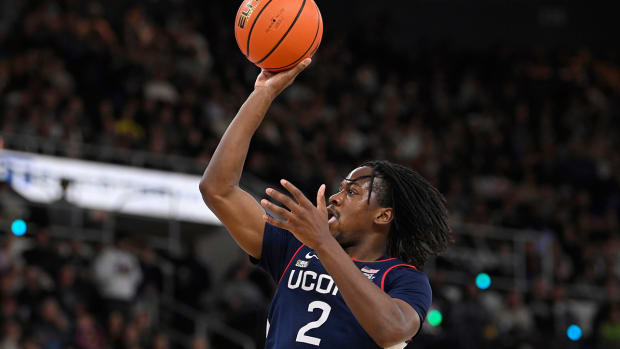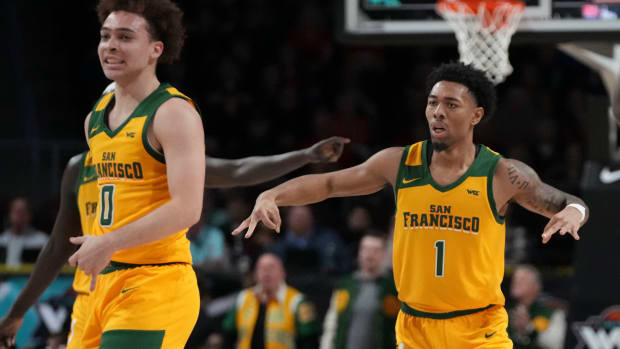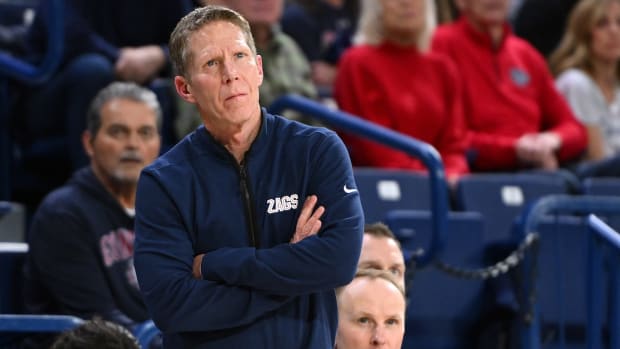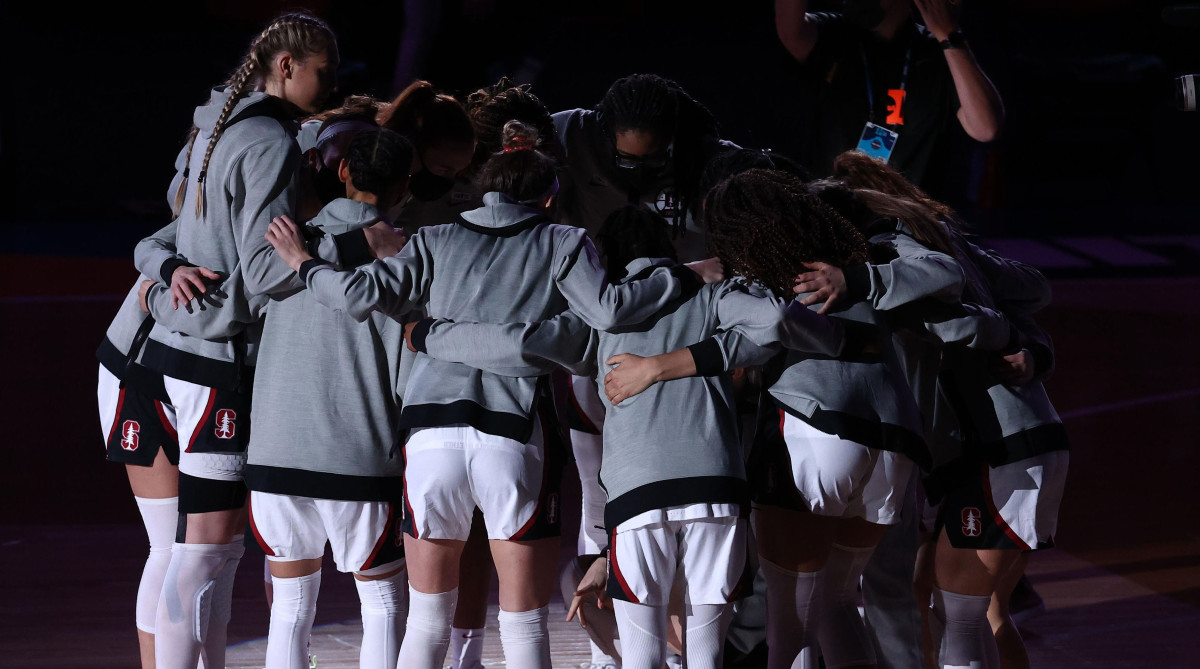
Student-Athlete Committee Members Speak Out to Oppose NCAA's Alternative NIL Proposal
Some of the most influential college athletes within the NCAA governance system are speaking out against the organization’s latest approach in regulating player compensation.
Three members of the Division I Student-Athlete Advisory Committee spoke to Sports Illustrated on Thursday in a passionate defense of the association’s original legislative proposal designed to govern how athletes can profit from their name, image and likeness (NIL). Ryan Cassidy, Brynn Carlson and Bryce Choate are united in their frustration over the NCAA’s 11th hour decision to abandon an exhaustive legislative policy for a simplified, alternative solution that has been deemed a temporary fix until a Congressional bill is passed.
The three current and former athletes made their pleas while sitting on high-ranking NCAA governing bodies this week. Cassidy, a former Rutgers football player, is the athlete representative on the DI Board of Directors, made up of presidents and chancellors. Carlson, a current Missouri women’s volleyball player, and Choate, a former Oral Roberts track and field athlete, sit on the NCAA DI Council, made up largely of athletic directors and conference commissioners.
The NCAA is favoring a temporary, alternative solution over the full legislative policy to avoid potential legal entanglements and conflicts with soon-to-be existing state NIL laws, as SI reported Wednesday night, news confirmed by both CBSSports and the Associated Press. Under the alternative plan, effective July 1, the NCAA would mostly exempt itself from NIL. Schools in states with an NIL law may follow that law without penalty, and schools located in states without a statute are granted permission to each create and administer their own NIL policy, as long as they use guiding principles such as prohibiting NIL ventures designed as pay-for-play or recruiting inducements.
“We understand the NCAA is trying to divert and give member schools the power to create their own guidelines, but uniformity would be the best possible situation,” says Cassidy, the national chair of SAAC. “By July 1, we are going to need to implement a standard of what NIL looks like. Right now it’s not about temporarily fixing this problem.
“The deflection needs to stop and we need to deal with this internally. We have the power to do that before July 1. We don't support the temporary option. We want it to be uniform.”

Stanford Cardinal players huddle on the court prior to their game against the Arizona Wildcats in the national championship game of the women's Final Four of the 2021 NCAA Tournament at Alamodome.
Troy Taormina/USA TODAY Sports
The athletes are in favor of the policy created by the NCAA Legislative Solutions Group, a committee of school and conference athletic officials who spent two years crafting a 30-page legislative proposal to govern NIL. The policy has twice been at the doorstep of approval. It was expected to be adopted in January, but a letter from the Department of Justice, raising antitrust issues within the document, delayed the passage. The DI Council was then expected to ratify the legislation this week at its meeting Tuesday and Wednesday.
However, the Supreme Court’s decision in the Alston case—a unanimous NCAA loss—resulted in the latest delay. The high court’s opinion raised concerns that any permanent NCAA legislation that restricts athletes' compensation would result in more successful legal challenges against the governing body. The alternative model offers a streamlined approach that, depending on each school’s policy, could grant just as many rights to athletes as permissive state laws.
That said, many institutions in states without an NIL law—at least seven states have a law set to kick in July 1—were preparing to follow the NCAA’s original legislative proposal for more than a year. Now, days before the July 1 effective date, these schools and their conferences must scramble to create NIL policies themselves with little guidance or oversight.
The variance and the last-minute pivot are at the core of the athletes’ qualms.
“This is frustrating. We were ready to vote on this in January and here we are in June talking about a new model,” says Choate, the newly promoted co-vice chair of SAAC with Carlson. “The alternative plan means hundreds of institutions coming up with their own policy at the drop of a hat. When you talk about what’s best for athletes, the Legislative Solutions Group’s proposal lets us hit the ground running. Colleges have been preparing based on it. They have documents ready.”
Some high-ranking NCAA committee members are more worried about avoiding legal challenges than creating an even playing field, Choate says. In a twist of irony, many of the legal cases brought against the NCAA are from athletes themselves.
The NCAA’s legal team spent much of the DI Council meeting Tuesday addressing such concerns. Choate responded by addressing his own issues, telling council members that they should emphasize the athletes’ voice instead of focusing on “self preservation.”
Permanent or temporary solution, “there’s going to be lawsuits either way,” says Choate, echoing what many sports law experts have told SI.
“There are members within these committees who I think are more concerned with litigation, and I think that gets in the way,” says Choate. “But there are a lot of members that have student athletes’ wealthfare at the forefront. Not every voice is as loud at these tables.”
It may come as a surprise to some that the NCAA’s ranking athlete members are in support of legislation that is more restrictive. But that’s not the way this trio sees it.
“We feel like the alternative solution being promoted doesn’t give athletes guidance on how to even pursue NIL. It creates so much complication and confusion,” says Carlson.
Carlson provides herself as an example. While she is from Minnesota, she attends school in Missouri. When striking NIL deals in her hometown, what NIL guidance is she expected to follow: the University of Missouri, the state of Missouri or the state of Minnesota?
And what about schools creating completely different NIL policies? Schools now have the choice to operate under more restrictive rules with guardrails or create a completely unrestricted policy.
“How am I supposed to understand what I can and can’t do?” she says. “How can I protect myself from adverse effects?”
The athletes aren’t alone in their objection to the alternative solution. This quandary—the unrestricted, alternative solution vs. the NCAA’s more restrictive, permanent legislation—is a divisive issue that has led to robust debate and somewhat fractured feelings among high-level conference administrators.
Some officials say the alternative plan “goes way too far” and that they’d prefer to begin with more restrictive rules before slowly working toward a more permissive model. One Power 5 administrator described the new solution as “disrespectful” to the NCAA Legislative Solutions Group.
“Clearly we have differences of opinion on the legal issues around this,” says one DI Council member.
For the institutions and conferences themselves, there are a multitude of issues in hurriedly creating NIL policy. In a restricted model, schools are at risk of being lambasted by the public and their own athletes and setting themselves up for a disadvantage against rival programs with more athlete-friendly rules. In an unrestricted model, schools are in jeopardy of facing conflicts with their own sponsors and uncomfortably violating what were decades-long NCAA rules.
Maybe most important, who enforces the NCAA’s two guiding principles of prohibiting recruiting inducements and pay-for-play? The principles are not policy and might not be enforceable. In fact, as to avoid legal issues, the DI Board of Directors would not create new policy but would grant relief of existing legislation, such as waiving the enforcement of NCAA bylaws that prohibit athletes earning compensation from their NIL.
“They’re racing. They’re in a tough spot and are trying to come up with rules on the fly and it’s difficult to do,” says Michael McCann, a law professor and sports law expert who recently testified in front of Congress about NIL. “Normally when people or groups try to race to get legal documents drafted, it’s not ideal.”
And so the pursuit of a solution marches on.
At a joint meeting Thursday between the DI Board of Directors and the Board of Governors, the two highest-ranking NCAA governing bodies, no decision was made, but they were all discussed, Cassidy says. The issue is now out for debate. The DI Council meets Monday and is expected to further discuss the matter, providing feedback to the DI Board of Directors ahead of its meeting Wednesday, where it’s expected to adopt a proposal.
“It’s more than about time that the exploitation of our labor ceases,” Cassidy says forcefully. “It’s more than about time for NIL to go through.”
More NCAA Coverage:
